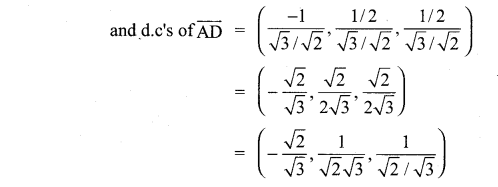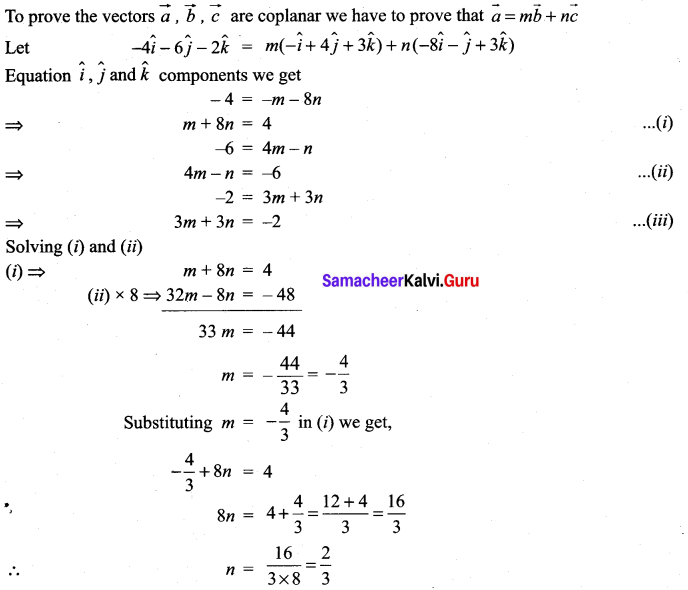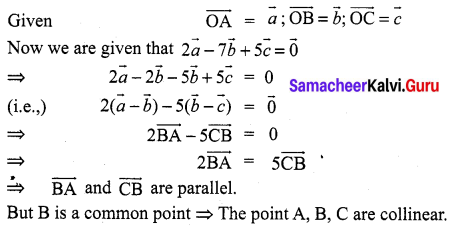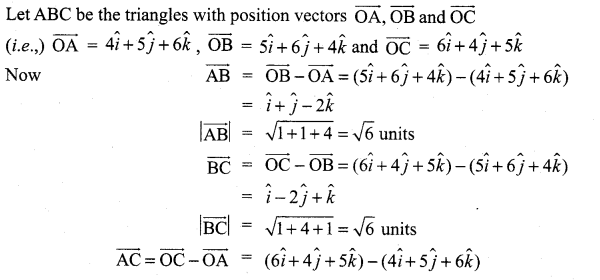You can Download Samacheer Kalvi 11th Maths Book Solutions Guide Pdf, Tamilnadu State Board help you to revise the complete Syllabus and score more marks in your examinations.
Tamilnadu Samacheer Kalvi 11th Maths Solutions Chapter 8 Vector Algebra – I Ex 8.2
Question 1.
Verify whether the following ratios are direction cosines of some vector or not.

Solution:

Question 2.
Find the direction cosines of a vectors whose direction ratios are
(i) 1, 2, 3
(ii) 3, -1, 3
(iii) 0, 0, 7
Solution:

Question 3.
Find the direction cosines and direction ratios for the following vectors

Solution:



![]()
Question 4.
A triangle is formed by joining the points (1, 0, 0), (0, 1, 0) and (0, 0, 1). Find the direction cosines of the medians.
Solution:



Question 5.
If \(\frac{1}{2}, \frac{1}{\sqrt{2}}\), a are the direction cosines of some vector, then find a.
Solution:

Question 6.
If (a, a + b, a + b + c) is one set of direction ratios of the line joining (1, 0, 0) and (0, 1, 0), then find a set of values of a, b, c.
Solution:
Given (a, a + b, a + b + c) is one set of direction ratios of the line joining (1, 0, 0) and (0, 1, 0) then find a set of values of a, b, c.
Let the given points be A (1, 0, 0) and B (0, 1, 0)
[The direction ratios of the line joining the points A (x1, y1, z1) and B (x2, y2, z2) are x2 – x1, y2 – y1, z2 – z1 or x1 – x2, y2 – y2, z1, z1 – z2 j
The direction ratios of the line joining the points A(1, 0, 0) and B(0, 1, 0) are
(0 – 1, 1 – 0, 0 – 0)
(- 1, 1, 0) ………. (1)
Also the direction ratios are
(1 – 0, 0 – 1, 0 – 0)
(1, -1, 0) ………. (2)
Given the direction ratios are
(a, a + b , a + b + c) ………. (3)
Comparing (1) and (3) we have
(-1, 1, 0) = (a, a + b, a + b + c)
a = -1, a + b = 1 ⇒ – 1 + b = 1 ⇒ b = 2
a + b + c = 0 ⇒ – 1 + 2 + c = 0 ⇒ c = – 1
Comparing (2) and (3) we get
a = 1 , a + b = – 1 ⇒ 1 + b = – 1 ⇒ b = – 2
a + b + c = 0 ⇒ 1 – 2 + c = 0 ⇒ c = 1
∴ The required set of values of a, b, c are
a = -1, b = 2, c = – 1 and
a = 1, b = – 2, c = 1
Question 7.
Show that the vectors \(2 \hat{i}-\hat{j}+\hat{k}, 3 \hat{i}-4 \hat{j}-4 \hat{k}, \hat{i}-3 \hat{j}-5 \hat{k}\) form a right angled triangle.
Sol:

⇒ The given vectors form the sides of a right-angled triangle.
![]()
Question 8.
Find the value of k for which the vectors \(\vec{a}=3 \hat{i}+2 \hat{j}+9 \hat{k}\) and \(\vec{b}=\hat{i}+\lambda \hat{j}+3 \hat{k}\) are parallel.
Solution:

Question 9.
Show that the following vectors are coplanar.

Solution:
Let the given three vectors be \(\vec{a}\), \(\vec{b}\) and \(\vec{c}\). When we are able to write one vector as a linear combination of the other two vectors, then the given vectors are called coplanar vectors.




We are able to write \(\vec{a}\) as a linear combination of \(\vec{b}\) and \(\vec{c}\)
∴ The vectors \(\vec{a}\), \(\vec{b}\), \(\vec{c}\) are coplanar
Question 10.
Show that the points whose position vectors ![]() and
and ![]() are coplanar
are coplanar
Solution:
Let the given points be A, B, C and D. To prove that the points A, B, C, D are coplanar, we have to prove that the vectors \(\overrightarrow{\mathrm{AB}}, \overrightarrow{\mathrm{AC}}\) and \(\overrightarrow{\mathrm{AC}}\) are coplanar



∴ we are able to write one vector as a linear combination of the other two vectors ⇒ the given vectors \(\vec{a}\), \(\vec{b}\), \(\vec{c}\) are coplanar.
(i.e.,) the given points A, B, C, D are coplanar.
Question 11.
If \(\vec{a}=2 \hat{i}+3 \hat{j}-4 \hat{k}\), \(\vec{b}=3 \hat{i}-4 \hat{j}-5 \hat{k}\) and \(\vec{c}=-3 \hat{i}+2 \hat{j}+3 \hat{k}\), find the magnitude and direction cosines of
(i) \(\vec{a}+\vec{b}+\vec{c}\)
(ii) \(3 \vec{a}-2 \vec{b}+5 \vec{c}\)
Solution:

 >
>
Question 12.
The position vectors of the vertices of a triangle are ![]() and
and ![]() . Find the perimeter of the triangle
. Find the perimeter of the triangle
Solution:
Let A, B, C be the vertices of the triangle ABC,

Question 13.
Find the unit vector parallel to ![]() and
and ![]()
Solution:
![]()

Question 14.
The position vector \(\vec{a}\), \(\vec{b}\), \(\vec{c}\) three points satisfy the relation \(2 \vec{a}-7 \vec{b}+5 \vec{c}=\overrightarrow{0}\). Are these points collinear?
Solution:

![]()
Question 15.
The position vectors of the points P, Q, R, S are ![]() and
and ![]() respectively. Prove that the line PQ and RS are parallel.
respectively. Prove that the line PQ and RS are parallel.
Solution:

Question 16.
Find the value or values of m for which \(m(\hat{i}+\hat{j}+\hat{k})\) is a unit vector
Solution:

Question 17.
Show that points A(1, 1, 1), B(1, 2, 3), and C(2, -1, 1) are vertices of an isosceles triangle.
Solution:

Samacheer Kalvi 11th Maths Solutions Chapter 8 Vector Algebra – I Ex 8.2 Additional Problems
Question 1.
Show that the points whose position vectors given by
![]()
![]()
Solution:


Question 2.
Find the unit vectors parallel to the sum of \(3 \hat{i}-5 \hat{j}+8 \hat{k}\) and \(-2 \hat{j}-2 \hat{k}\)
Solution:

Question 3.
The vertices of a triangle have position vectors ![]() Prove that the triangle is equilateral.
Prove that the triangle is equilateral.
Solution:


![]()
Question 4.
Prove that the points ![]() form an equilateral triangle.
form an equilateral triangle.
Solution:

Question 5.
Examine whether the vectors ![]() are coplanar
are coplanar
Solution:


⇒ We are not able to write one vector as a linear combination of the other two vectors
⇒ the given vectors are not coplanar.